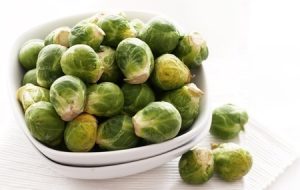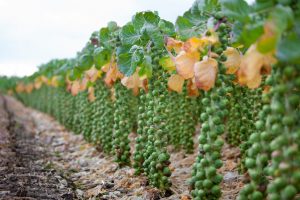Brussels sprouts are not just for Christmas, they are a must on the winter vegetable table, especially for those of us living in the cooler climes of the world. We cook them after they have had the first severe frosts because it sweetens them up beautifully. They are not difficult to grow either ! They are related to cabbages, broccoli and cauliflowers because Brussels Sprouts belong to the Brassica family.

There have been a number of hybrids, all F1 to enter the market with exceptional flavour. There is a red-buttoned variety called ‘Red Bull’ which is a clear red button type.
The Brussels sprout has its detractors; they are not everybody’s favourite vegetable but they are certainly one of mine. The finest dish you can have is a side order of sprouts with Chicken Tikka Masala. It’s strange to think they were first found as a sport on a cabbage plant in 1750, around the city of Brussels and the name has stuck ever since.
Cultivation & Growing
I start plants from seed and usually under cover in March into ordinary soil although compost gives the best results. A seed per cell tray is ideal.
When it comes to a growing location, a sunny site with reasonably good soil that is sheltered from hard winds is ideal. Add up to two bucket loads of well-rotted manure per square metre, and before planting or sowing add 150g (5oz) per square metre/yard of a general purpose fertiliser.
Plant out the young plants from mid-May to early June into well watered soil, when they are 10-15cm (4-6in) high and have seven ‘true’ leaves. It is best to transplant into their growing positions, leaving 60-70cm (2-2½ft.) between plants and 75cm (2½ft) between rows. Just re-water again to allow the roots to settle into their new home.
Water every 10-14 days in periods of dry weather. The plants benefit from a top-dressing of high nitrogen fertiliser such as dried poultry manure pellets at 150g (5oz) per square metre/yard in July.
Mound enough soil around the base in September to support the plants.

Harvesting
The earliest varieties of Brussels Sprouts can be harvested from August before frosts arrive but lack a certain sweetness although they are ideal when cooked with spices or curry powder. It is best to start from the lowest sprouts, when they are tightly closed, firm and the size of a walnut. These are snapped off with a sharp downward tug. Most other varieties are harvested after the frosts have taken their toll of other plants where they convert starch to sugars. At the end of the season the sprout tops can be harvested and eaten.
Problems:
Pigeons are highly problematic as they prefer to nibble the fresh leaves. Generally, birds have always been an issue with brassicas as thy eat seedlings, buds, leaves and so on. It is best to cover the young plants with netting or fleece.
Club root leads to distortion on the plant with wilted yellow leaves and is caused by a virus. The best treatment is to add lime which raises the pH but it is best not to grow on affected soil until the issue has cleared.
Cabbage root fly is a white larvae which attacks most brassicas. They are about 5 cm (2in) long and feed on the roots just below the soil surface. Like vine weevil, that eat roots which causes general plant wilt and death.
The Cabbage White butterfly lays eggs on the leaves in late summer and the caterpillars can easily strip a plant. The best treatment is to hand-pick or spray with pyrethrum, deltamethrin or a form of cyhalothrin. Insect-proof mesh or fine netting (5-7mm mesh size) works but there must be suitable distance from the leaves to prevent the butterfly laying its eggs.
Clubroot Resistant Varieties To Try. If clubroot is a major issue on your soil, then try these four resistant varieties for sowing. They include a cauliflower (cv.Clapton), brussel sprout (cv. Crispus), calabrese (cv. Monclano) and the cabbage (cv. Kilaton).
Varieties Of Brussels Sprouts
‘Abacus’ AGM: Early to mid season. Good crop of dark green, solid, round sprouts with a strong taste.
‘Attwood’ F1 AGM in 2016; Stands well producing clean, medium-sized, pale green buttons. No harshness claimed in its flavour – in other words its quite mild. Some think this one would be ideal for children to eat. A good one for extending the Brussels Sprout season well into the new year with what is an excellent, British-bred variety. .
‘Bosworth’ AGM: Late. Oval sprouts, which are dark green, solid and closely spaced, so easy to pick. Stands well and retains quality until February.
‘Brodie F1′ AGM – A formidable and exceptional Brussels sprout with a mild, almost sweet flavour. Another British-bred variety which is ready for harvesting from late November onwards and produces a high yield of medium to large, dark green sprouts which can hold well on the plant going into the new year.
‘Chronos‘: New, clubroot resistant, mid-season, good crop of well-formed, tasty sprouts.
‘Crispus F1’ AGM in 2016: Has clubroot resistance. Early to mid-season hybrid producing firm mid- to dark-green buttons. These buttons stand in good condition on what are relatively tall plants for several weeks. Cooking reduces the taste by half apparently.
‘Diablo’ AGM: Mid to late season. Vigorous and tolerant of poor soils, smooth round, mid to dark green sprouts.
‘Doric’ AGM in 2016: Very late – cropping into early February. Buttons turn darker green on cooking and has a slight bitterness which is ideal for stews etc.
‘Green Marble’ AGM in 2016; Produces nicely spaced, smooth, round and large buttons with a pleasant, slightly walnutty note. Excellent eaten raw and cooked.
‘Marte’ AGM in 2016; Buttons well and the taste is strong but not bitter. Can be eaten raw and cooked.
‘Maximus’ AGM in 2006 and reconfirmed in 2016: Early to mid-season. Uniform plants with mid to dark green, smooth, dense sprouts.
‘Revenge’ AGM: Very Late. Vigorous and tolerant of poor soils, with high yields of nutty flavoured sprouts; it stands well. A well spaced cropping variety, easy-to-pick sprouts. Stands well and retains its quality until February or later.
Leave a Reply